Discover 7 veterinarian-approved pet anxiety relief techniques that actually work. From behavior modification to natural remedies, help your anxious pet find calm. Learn more now!
Table of Contents
Introduction: Understanding the Silent Struggle of Pet Anxiety
Watching your beloved companion shake uncontrollably during a thunderstorm or destroy your home while you’re away isn’t just frustrating—it’s heartbreaking. Pet anxiety affects millions of animals worldwide, yet many owners feel helpless when confronted with their pet’s distress. According to the American Veterinary Medical Association, nearly 20% of the 76.8 million dogs and 58.4 million cats in the US suffer from some form of anxiety, making pet anxiety relief one of the most sought-after solutions among caring pet parents.
Whether triggered by separation, loud noises, unfamiliar environments, or past trauma, anxiety can significantly impact your pet’s quality of life and your relationship with them. The good news? Effective pet anxiety relief strategies exist, and implementing the right combination can transform your anxious companion into a more relaxed, confident animal.
In this comprehensive guide, we’ll explore seven scientifically-backed, veterinarian-approved pet anxiety relief techniques that produce real results. From behavior modification strategies to natural remedies and professional interventions, these approaches address the root causes of pet anxiety rather than merely masking symptoms.
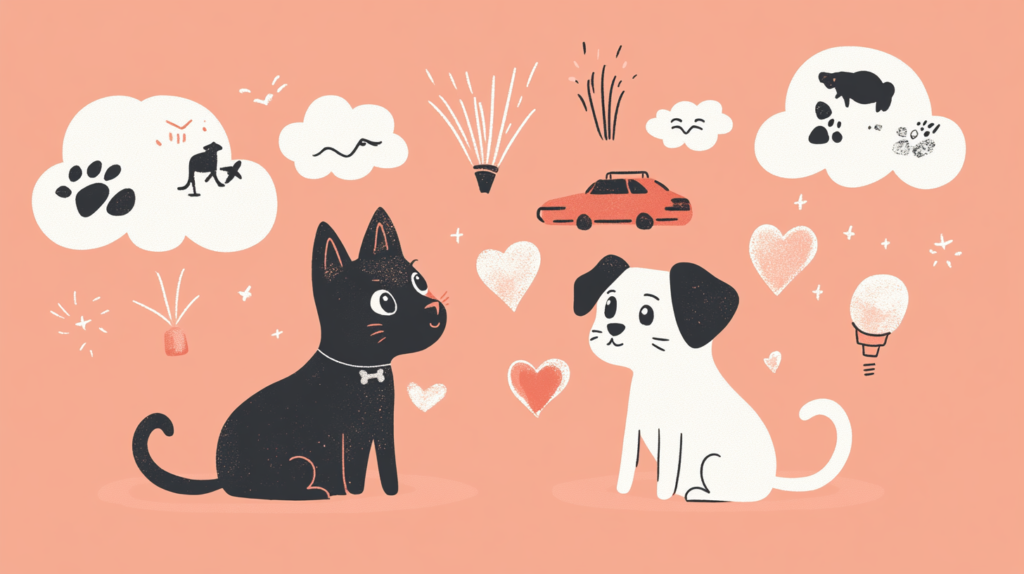
What Causes Pet Anxiety?
Before diving into solutions, it’s essential to understand what might be triggering your pet’s anxiety:
Common Anxiety Triggers in Pets
- Separation anxiety: Fear of being left alone
- Noise phobias: Thunderstorms, fireworks, construction sounds
- Travel anxiety: Car rides, airplane trips, unfamiliar surroundings
- Social anxiety: Unfamiliar people or other animals
- Post-traumatic stress: From past abuse, neglect, or traumatic experiences
- Age-related anxiety: Cognitive decline in senior pets
- Health-related anxiety: Pain or illness causing emotional distress
Dr. Karen Overall, veterinary behaviorist and researcher at the University of Pennsylvania, notes that “Anxiety disorders in pets often go undiagnosed because many owners misinterpret anxiety symptoms as ‘bad behavior’ rather than recognizing them as signs of genuine emotional distress.”
Understanding your pet’s specific anxiety triggers is crucial for implementing the most effective pet anxiety relief strategies. Now, let’s explore the seven techniques that veterinary behaviorists consistently report as most effective.
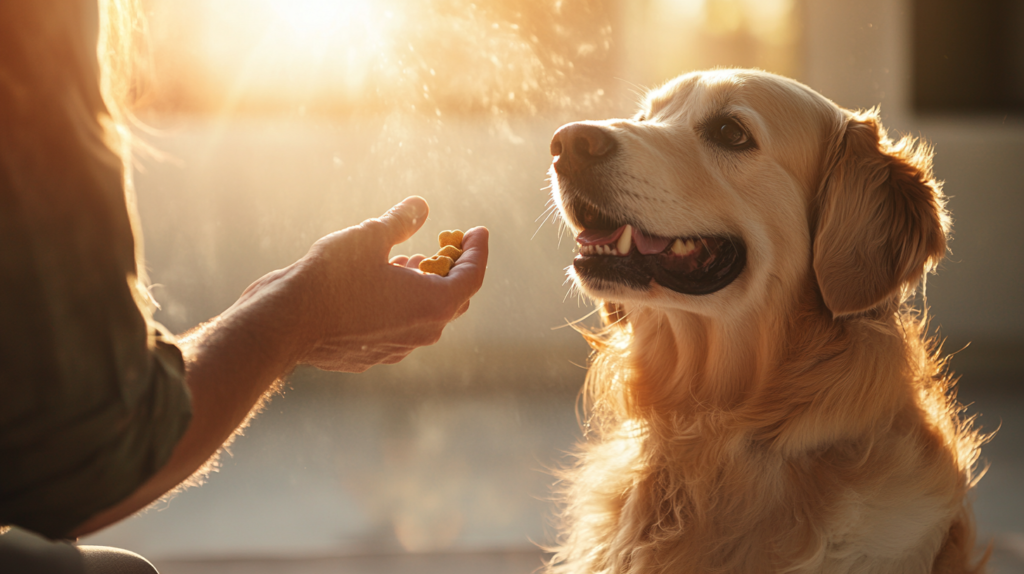
1. Behavior Modification: The Foundation of Lasting Pet Anxiety Relief
Behavior modification techniques form the cornerstone of effective pet anxiety relief. Unlike quick fixes that temporarily mask symptoms, these approaches address the underlying causes of anxiety and create lasting change.
Desensitization and Counterconditioning
Desensitization gradually exposes your pet to their anxiety trigger at such a low intensity that it doesn’t provoke fear. Over time, you slowly increase exposure while keeping your pet calm, helping them build tolerance.
Counterconditioning pairs this exposure with something positive (usually high-value treats) to transform their emotional response from fear to pleasure.
How to implement it:
- Identify your pet’s specific anxiety trigger (e.g., thunderstorms)
- Create a “hierarchy” of exposure intensity (e.g., play thunder sounds at 10% volume, then 20%, etc.)
- Begin with the lowest intensity that doesn’t cause anxiety
- Pair each exposure with exceptional treats or play
- Only increase intensity when your pet shows no signs of stress at the current level
- Practice consistently for 5-10 minutes daily
A 2019 study published in the Journal of Veterinary Behavior found that consistent desensitization and counterconditioning reduced anxiety symptoms in 73% of dogs with noise phobias when practiced for at least 8 weeks.
Creating Positive Associations
For pets with specific anxiety triggers like car rides or vet visits, building positive associations can dramatically reduce anxiety.
Case Study: Bailey, a 4-year-old rescue dog, would tremble uncontrollably during car rides. His owner began a systematic program where Bailey would first just sit in the stationary car and receive special treats. Over three weeks, she gradually progressed to short drives around the block paired with treats and praise. Six weeks later, Bailey would eagerly jump into the car, showing how effective positive association can be as a pet anxiety relief technique.
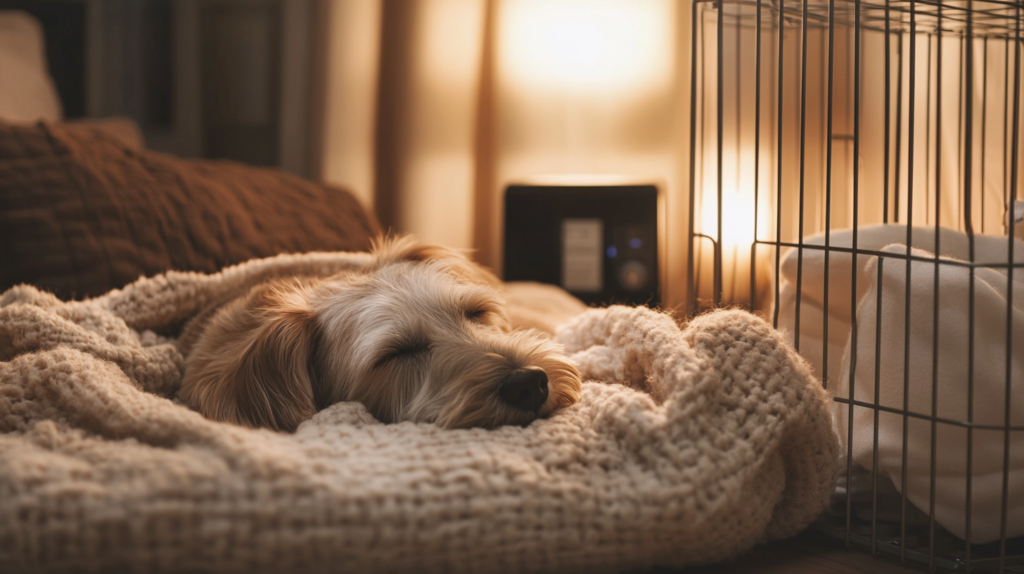
2. Environmental Modifications: Creating Safe Spaces
Sometimes, the most effective pet anxiety relief comes from modifying your home environment to create security and predictability.
Dedicated Safe Zones
Creating a designated “safe space” gives anxious pets a retreat where they can self-soothe when feeling overwhelmed.
Elements of an effective safe space:
- Location: Choose a quiet area away from household traffic
- Comfort: Include their bed, familiar blankets, and comfort toys
- Security: Consider a covered crate (for dogs) or elevated perch (for cats)
- Sensory management: Use white noise machines to block startling sounds
- Familiar scents: Add items with your scent or pheromone products
| Safe Space Element | Purpose | Examples |
| Comfort Items | Provide security | Favorite beds, blankets with owner’s scent |
| Sound Management | Reduce auditory triggers | White noise machine, calming music |
| Visual Barriers | Create sense of security | Covered crates, hiding spots for cats |
| Temperature Control | Optimize comfort | Cooling mats, heated beds as needed |
| Pheromone Products | Chemical signals of safety | Adaptil (dogs), Feliway (cats) |
Enrichment and Predictability
Anxious pets often thrive on predictability and mental stimulation. A consistent daily routine combined with appropriate enrichment can significantly reduce baseline anxiety levels.
Environmental enrichment ideas for anxiety relief:
- Food puzzles: Transform mealtime into mentally stimulating activities
- Rotation system: Regularly rotate toys to maintain novelty
- Sensory gardens: Create outdoor spaces with various textures and safe plants to explore
- Vertical space: For cats, install climbing opportunities and elevated resting areas
- Background noise: Leave on calming music or television when away from home
Dr. Sophia Yin, renowned veterinary behaviorist, emphasized that “Environmental management isn’t just about removing stressors—it’s about creating a world where your pet feels empowered, engaged, and secure.
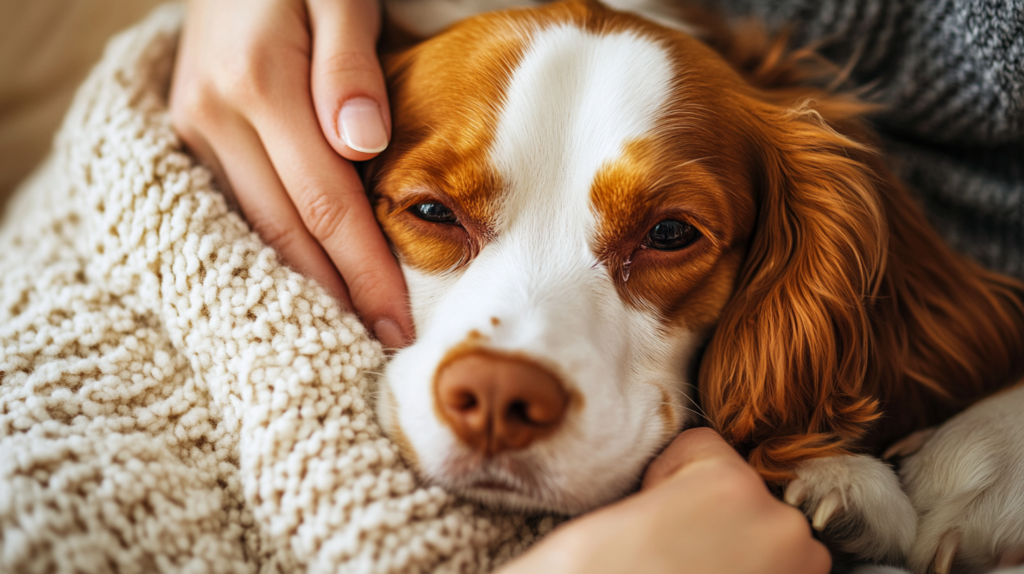
3. Physical Contact Techniques: The Power of Touch
Touch therapy provides immediate pet anxiety relief by triggering the release of oxytocin and endorphins—neurochemicals that promote feelings of safety and well-being.
Pressure Therapy
Many anxious pets respond remarkably well to gentle, sustained pressure across their body. This technique is based on the same principles as weighted blankets for humans with anxiety.
Application methods:
- Commercial anxiety wraps: Products like ThunderShirt apply gentle, constant pressure
- DIY pressure wraps: Using an ACE bandage wrapped in a specific pattern (consult instructional videos)
- Body wrapping: For larger dogs, sustained hugging with gentle pressure
A clinical trial published in the Journal of Veterinary Behavior found that pressure wraps reduced symptoms of anxiety in 80% of dogs during thunderstorms and fireworks.
Massage and TTouch
Specific touch techniques can calm the nervous system and release muscle tension caused by chronic anxiety.
Effective touch therapies:
- TTouch: Developed by Linda Tellington-Jones, this technique uses specific circular touches, lifts, and slides
- Acupressure: Applying gentle pressure to specific points associated with relaxation
- Slow strokes: Long, slow strokes down the back and sides at a consistent pace
“When properly applied, touch therapies activate the parasympathetic nervous system—the body’s natural brake pedal for the stress response,” explains Dr. Karen Becker, integrative veterinarian.
Implementation tip: Practice touch therapies during calm periods, not just during anxiety episodes. This builds a conditioned relaxation response that your pet can access during stressful situations.
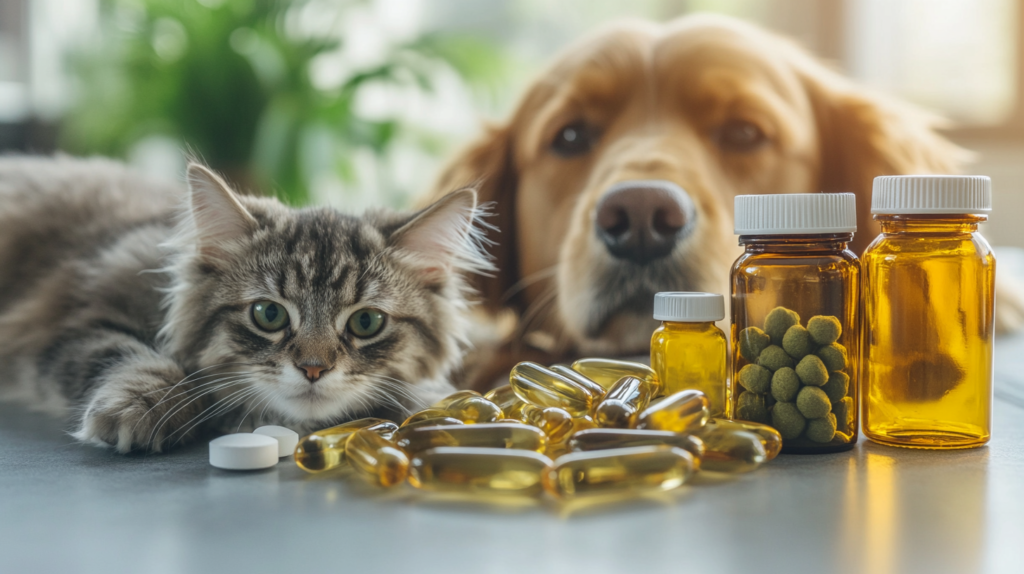
4. Natural Supplements and Nutraceuticals
Many pet owners seek natural approaches to pet anxiety relief before turning to prescription medications. Several scientifically-studied supplements show promise for reducing anxiety symptoms.
Scientifically-Backed Supplements
L-Theanine: An amino acid found naturally in green tea that promotes relaxation without sedation. Research in the Journal of Veterinary Behavior showed L-theanine supplementation reduced stress behaviors in 82% of thunder-phobic dogs.
Dosage range: 100-400mg daily, depending on pet size (always consult your veterinarian)
Omega-3 Fatty Acids: These essential fats support brain health and modulate stress responses. A 2018 study in the Journal of Animal Physiology and Animal Nutrition found that dogs receiving omega-3 supplementation showed reduced anxiety behaviors compared to control groups.
Typical sources: Fish oil supplements specifically formulated for pets, with dosing based on EPA and DHA content
Magnolia and Phellodendron (Harmonease): This herbal combination has been shown to reduce cortisol levels and anxiety behaviors in multiple clinical trials.
Caution: While natural, supplements can interact with medications or be inappropriate for pets with certain health conditions. Always consult your veterinarian before starting any supplement regimen.
Pheromone Products
Synthetic versions of natural calming pheromones can significantly reduce anxiety in many pets:
- Dogs: Adaptil mimics the “appeasing pheromone” mother dogs release to calm their puppies
- Cats: Feliway replicates facial pheromones cats deposit when they feel secure in their territory
These products come in diffusers, sprays, and wearable formats. A meta-analysis of 14 clinical studies published in the Journal of Feline Medicine and Surgery found pheromone products effective in reducing anxiety behaviors in 74.2% of cats.
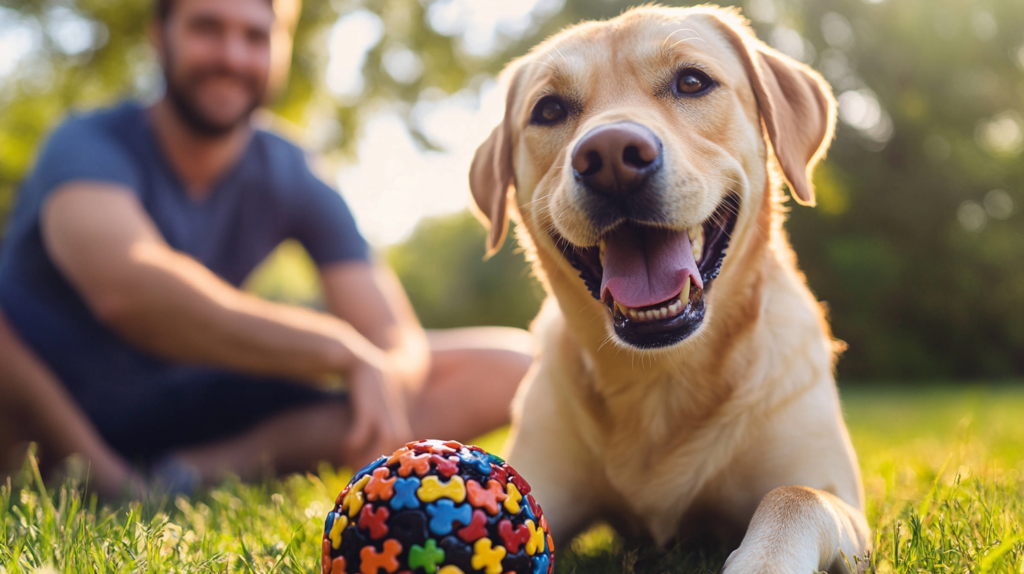
5. Structured Exercise and Mental Stimulation
Physical and mental fatigue can be powerful tools for pet anxiety relief, particularly for high-energy breeds or young animals.
Physical Exercise for Anxiety Management
Regular, appropriate exercise depletes excess energy that might otherwise fuel anxiety and increases production of mood-regulating neurotransmitters like serotonin and dopamine.
Exercise recommendations by anxiety type:
- Separation anxiety: Schedule intense exercise 30-60 minutes before departures
- General anxiety: Daily aerobic activity (30-60 minutes for most dogs)
- Reactive behavior: Structured exercise in low-stimulation environments
Dr. Nicholas Dodman, founder of the Animal Behavior Clinic at Tufts University, notes that “For some dogs, particularly working breeds, lack of adequate physical exercise can amplify anxiety symptoms by up to 70%.”
Mental Enrichment Strategies
Mental fatigue can be even more effective than physical fatigue for calming anxious pets. Challenging your pet’s brain triggers problem-solving circuits that can override anxiety pathways.
Effective mental enrichment activities:
- Nosework games: Hide treats or toys for your pet to find using scent
- Training sessions: Short daily training of new skills or tricks
- Food puzzles: Devices that require problem-solving to access food
- Spatial challenges: Rearranging furniture occasionally to create new environments to explore
Real-world application: Emily’s Border Collie, Max, showed severe thunderstorm anxiety until she implemented a “Brain Games Before Storms” protocol. When weather forecasts predicted storms, she engaged Max in 20-30 minutes of advanced training and puzzle toys. The mental fatigue significantly reduced his anxiety response during subsequent storms.

6. Professional Behavioral Therapy
Sometimes, severe anxiety requires the expertise of professionals trained in animal behavior and pet anxiety relief techniques.
When to Seek Professional Help
Consider consulting a certified animal behaviorist or veterinary behaviorist if:
- Your pet’s anxiety is severe or worsening
- Anxiety is causing self-injury or destructive behavior
- Home-based interventions haven’t shown improvement after 4-6 weeks
- Your pet’s anxiety significantly affects their quality of life or your relationship
Types of Professional Interventions
Veterinary Behaviorists: These specialists are veterinarians with additional training in animal behavior. They can diagnose complex behavioral issues, rule out medical causes, and prescribe medications when appropriate.
Certified Applied Animal Behaviorists (CAAB): Professionals with advanced degrees in animal behavior who specialize in behavior modification protocols.
Professional Trainers with Behavior Specialization: Look for certifications like CPDT-KA or CBCC-KA with specific experience in anxiety cases.
According to data from the American College of Veterinary Behaviorists, professional intervention achieves significant improvement in 90% of pet anxiety cases when owners follow recommended protocols consistently.
Teleheath Options
Modern technology has made professional pet anxiety relief more accessible than ever. Many behaviorists now offer virtual consultations, allowing you to connect with specialists regardless of location.
Platforms like PetCoach and AirVet provide on-demand access to veterinary professionals who can offer guidance for anxiety management.
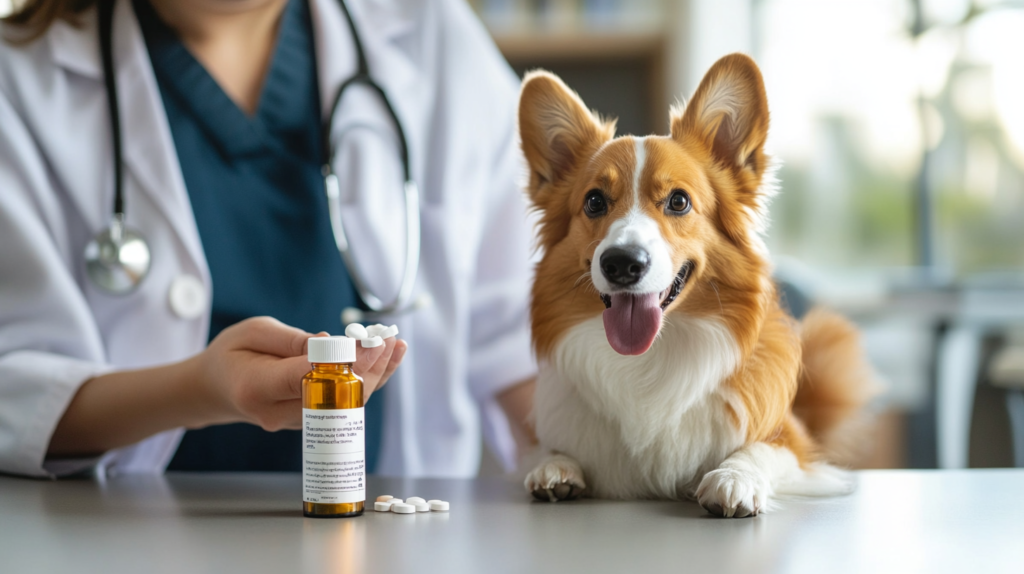
7. Pharmacological Interventions: When Medication Is Appropriate
While behavior modification forms the foundation of pet anxiety relief, some animals benefit significantly from appropriate medication to manage their condition.
Types of Anti-Anxiety Medications
Situational medications: For predictable anxiety triggers like thunderstorms or travel
- Trazodone
- Gabapentin
- Benzodiazepines (for short-term use)
Daily medications for chronic anxiety:
- Selective Serotonin Reuptake Inhibitors (SSRIs) like fluoxetine
- Tricyclic Antidepressants (TCAs) like clomipramine
- Selegiline for age-related anxiety
“Medication isn’t an admission of failure,” emphasizes veterinary behaviorist Dr. Meghan Herron. “For many pets with clinical anxiety disorders, appropriate medication creates the neurochemical balance needed for behavior modification to be effective.”
Medication Myths and Facts
Myth: Medication will change my pet’s personality. Fact: Properly prescribed anxiety medication normalizes brain chemistry, allowing your pet’s true personality to emerge from behind the anxiety.
Myth: Once started, my pet will need medication forever. Fact: Many pets can be gradually weaned off medication after behavior modification has created new neural pathways.
Myth: Medication is a quick fix that replaces training. Fact: Medication works best when combined with behavior modification techniques, creating a comprehensive pet anxiety relief program.
A 2020 study in the Journal of the American Veterinary Medical Association found that dogs receiving both behavior modification and appropriate medication showed 65% greater improvement than those receiving behavior modification alone.
Comprehensive Approach: Combining Strategies for Maximum Effect
The most successful pet anxiety relief programs incorporate multiple approaches tailored to your pet’s specific needs. Let’s examine how these techniques might be combined for common anxiety scenarios:
For Separation Anxiety
- Daily foundation: Structured exercise and mental enrichment before departures
- Environmental management: Safe space with comfort items and background noise
- Behavior modification: Systematic desensitization to departure cues
- Supplement support: L-theanine or pheromone products
- Professional guidance: Remote monitoring to assess progress
For Noise Phobias
- Preparation: Sound desensitization program during quiet seasons
- During events: Pressure therapy with ThunderShirt or similar product
- Environmental management: Sound-dampened safe space with masking noise
- Physical comfort: TTouch or massage techniques during events
- Possible medication: Situational anti-anxiety medication for severe reactions
The Importance of Consistency and Patience
Perhaps the most crucial aspect of any pet anxiety relief program is consistency. Neurological changes require time and repetition to become established. Dr. Marty Becker, “America’s Veterinarian,” reminds pet owners that “Anxiety wasn’t created overnight, and it won’t be resolved overnight. The most successful pet parents commit to consistent, daily practice of their chosen techniques.”
Most behavioral experts recommend giving any new approach at least 4-6 weeks of consistent implementation before evaluating its effectiveness or making significant changes.
Measuring Progress in Pet Anxiety Relief
How do you know if your chosen strategies are working? Consider tracking these objective measures:
- Duration of anxiety episodes: Are they becoming shorter?
- Recovery time: How quickly does your pet return to normal after a trigger?
- Physiological signs: Reduced panting, trembling, or drooling
- Sleep quality: Improvement in depth and duration of sleep
- Appetite changes: Return of normal eating patterns
- Reduction in avoidance behaviors: Willingness to enter previously feared situations
Many pet anxiety experts recommend keeping a simple journal to track these metrics, which can reveal gradual improvements that might otherwise go unnoticed.
Products That May Help with Pet Anxiety Relief
While not substitutes for the strategies above, certain products can enhance your pet anxiety relief program:
- ThunderShirt and similar pressure wraps: Provides gentle, constant pressure
- Through a Dog’s Ear/Through a Cat’s Ear: Specially designed audio for calming
- Snuggle Puppy/Snuggle Kitty: Toys with heartbeat simulators and heat packs
- Calming caps/Thundercaps: Reduces visual stimulation during stressful events
- Adaptive harnesses: For dogs who become reactive on walks
Tips for Special Anxiety Situations
Travel Anxiety
- Practice short car trips to positive destinations (not just the vet)
- Use a properly secured carrier or harness to increase physical security
- Consider anti-nausea medication if motion sickness contributes to anxiety
- Maintain familiar routines as much as possible while traveling
Vet Visit Anxiety
- Schedule “happy visits” where your pet just receives treats at the clinic
- Use familiarity items (blankets, toys) during visits
- Request the first appointment of the day to minimize waiting room time
- Practice handling similar to veterinary exams at home with positive reinforcement
New Pet Anxiety
- Create a small, contained space for initial adjustment rather than full house access
- Maintain a predictable schedule from day one
- Allow exploration at the pet’s pace without forced interaction
- Use pheromone products throughout the adjustment period
For more expert pet care tips and product recommendations, visit BlithePet.com — your trusted source for pet wellness.
FAQ: Pet Anxiety Relief
Q: How can I tell if my pet has anxiety or is just being “naughty”?
A: Anxiety behaviors serve a purpose for your pet—they’re attempts to cope with emotional distress, not deliberate disobedience. Signs that a behavior stems from anxiety include its predictable occurrence in specific situations, physical symptoms like panting or trembling, and the behavior persisting despite consistent training. Consulting with a veterinarian can help distinguish between behavioral problems and anxiety.
Q: Can pets develop anxiety suddenly, or does it always develop gradually?
A: While many anxiety disorders develop gradually, pets can develop sudden-onset anxiety following traumatic events like being in a car accident, experiencing extreme weather events, or after painful medical procedures. Age-related anxiety can also appear relatively quickly as cognitive changes occur in senior pets. Any sudden behavioral change warrants a veterinary check to rule out medical causes.
Q: Is medication for pet anxiety a lifelong commitment?
A: Not necessarily. Many pets require medication temporarily while behavior modification techniques take effect. Others may need seasonal medication (for example, during thunderstorm season) or situational medication for specific triggers like travel. Some pets with severe anxiety disorders may benefit from long-term medication, but many can be gradually weaned off under veterinary supervision once new coping skills are established.
Q: Can I use human anxiety supplements for my pet?
A: While some supplements like L-theanine are used for both humans and animals, human formulations often contain different dosages or additional ingredients that may be harmful to pets. Always use supplements specifically formulated for pets and consult with your veterinarian before starting any supplement regimen. Human medications for anxiety should never be given to pets without veterinary prescription, as they can cause serious harm.
Q: Do certain breeds experience more anxiety than others?
A: Research suggests there may be genetic components to anxiety tendencies. Herding breeds like Border Collies and Australian Shepherds often show higher rates of noise sensitivity and hypervigilance. Small breeds like Chihuahuas and Maltese may be predisposed to separation anxiety. Working breeds may be more prone to anxiety when under-stimulated. However, individual temperament, early socialization, and life experiences play equally important roles in determining anxiety vulnerability.
Q: How does anxiety in cats differ from anxiety in dogs?
A: Cats often show more subtle signs of anxiety than dogs, which many owners miss. While dogs might destroy property or vocalize when anxious, cats more commonly hide, over-groom (sometimes causing bald spots), develop litter box issues, or show increased aggression. Cats typically benefit from vertical space and hiding opportunities as part of their anxiety management, while dogs often respond better to interactive reassurance techniques.
Conclusion: Compassionate, Consistent Pet Anxiety Relief
Helping an anxious pet find relief requires patience, consistency, and compassion. By understanding the underlying causes of your pet’s anxiety and implementing appropriate techniques from the seven strategies covered, you can dramatically improve their quality of life—and strengthen your bond in the process.
Remember that anxiety exists on a spectrum, and what works for one pet may not work for another. Be willing to adjust your approach based on your pet’s individual response, and don’t hesitate to seek professional guidance when needed.
With the right combination of behavior modification, environmental management, and possibly appropriate supplements or medication, most anxious pets can experience significant improvement. The journey may require time and dedication, but the reward—a more relaxed, confident companion—is immeasurable.
Have a similar experience with your pet? Share it in the comments below!


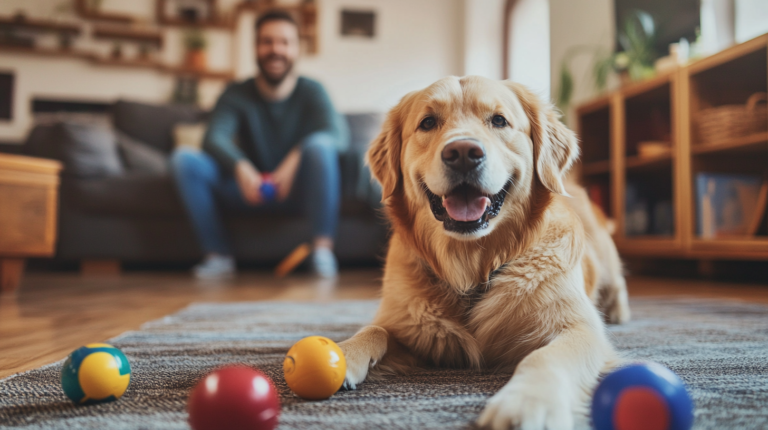
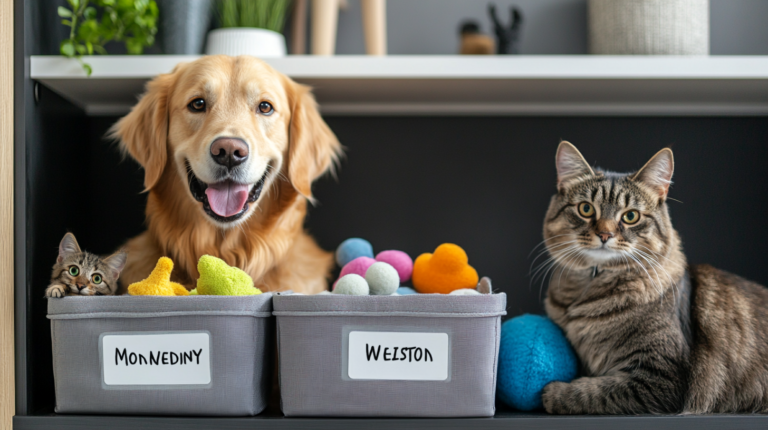
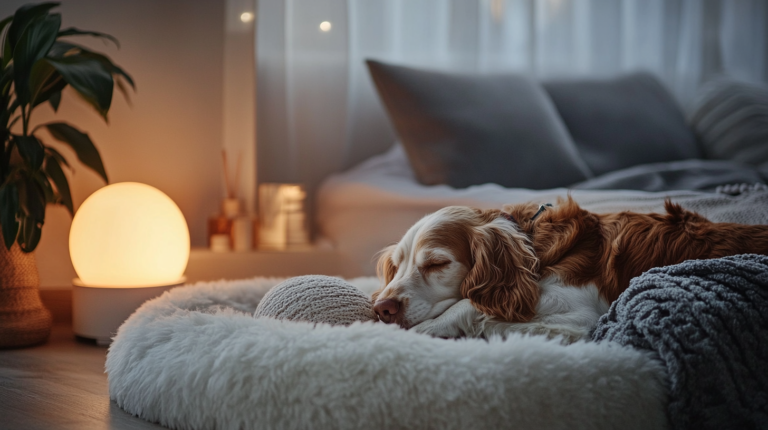

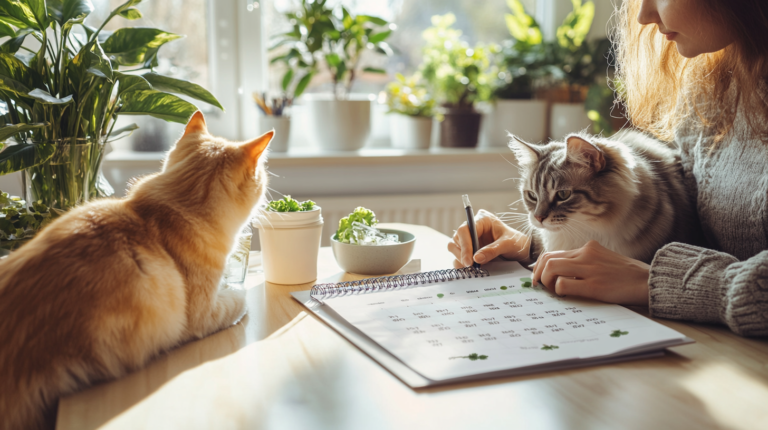

Leave a Reply